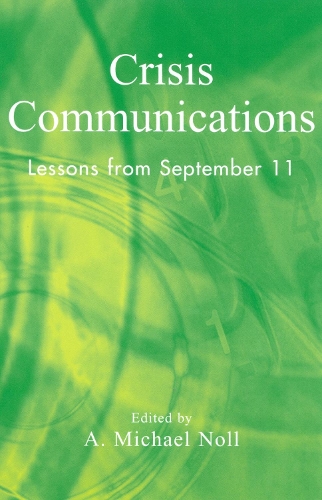
Crisis Communications: Lessons from September 11
(Paperback)
Publishing Details
Crisis Communications: Lessons from September 11
By (Author) Michael A. Noll
Other primary creator Peter Clarke
Contributions by James Alleman
Contributions by Sandra Ball-Rokeach
Contributions by Menahem Blondheim
Contributions by James William Carey
Contributions by John Carey
Contributions by Elisia Cohen
Contributions by William H. Dutton
Contributions by Joachim W. H. Haes
Bloomsbury Publishing PLC
Rowman & Littlefield Publishers
11th November 2003
United States
Classifications
General
Non Fiction
Media studies
Military and defence strategy
302.23
Physical Properties
Paperback
256
Width 158mm, Height 228mm, Spine 21mm
381g
Description
On September 11, 2001, AT&T's traffic was 40 percent greater than its previous busiest day. Wireless calls were made from the besieged airplanes and buildings, with the human voice having a calming influence. E-mail was used to overcome distance and time zones. And storytelling played an important role both in conveying information and in coping with the disaster. Building on such events and lessons, Crisis Communications features an international cast of top contributors exploring emergency communications during crisis. Together, they evaluate the use, performance, and effects of traditional mass media (radio, TV, print), newer media (Internet, email), conventional telecommunications (telephones, cell phones), and interpersonal communication in emergency situations. Applying what has been learned from the behavior of the mass media in past crises, the authors clearly show the central role of communications on September 11. They establish how people learned of the tragedy and how they responded; examine the effects of media globalization on terrorism; and, in many cases, give specific advice for the future.
Reviews
The book provides an unusual and compelling look at communication in a time of national crisis. Given its diverse chapters and unique approach, it should be of great interest to a variety of communication scholars and would fit nicely into a number of undergraduate and graduate courses that examine communication processes and effects within mediated, organization, and interpersonal contexts. * Journalism & Mass Communication Quarterly *
This is a very useful scholarly assessment of communication during a crisis. Recommended. * Choice Reviews *
Author Bio
A. Michael Noll is a professor at the Annenberg School for Communication at the University of Southern California. He is also affiliated with the Columbia Institute for Tele-Information at Columbia University's Business School and the Media Center at New York Law School.
